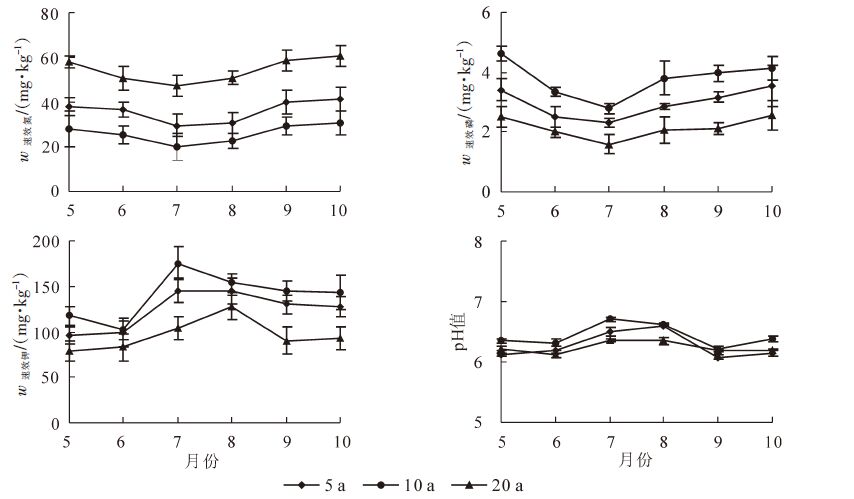-
土壤速效养分是指土壤所提供的植物生活所必需的易被作物吸收利用的营养元素,是评价土壤自然肥力的主要因素之一[1]。土壤酶是土壤一切生物化学过程的积极参与者[2],它不仅可以表征土壤物质能量代谢程度,而且可以作为评价土壤肥力高低和生态环境质量优劣的一个重要生物指标[3]。土壤养分与土壤酶联系非常紧密[3]。林分类型[4]、土壤类型 [5-7]、海拔高度[8]、林下植被[9]等立地条件影响土壤养分含量与土壤酶活性以及两者之间的关系,其中,季节变化也是一个非常重要的因素,并对其有明显的影响 [10-11]。华北落叶松 Larix principis-rupprechtii属松科Pinaceae落叶松属Larix,是中国暖温带亚高山地区的代表性森林类型,主要分布于河流的发源地,在水源涵养和水土保持方面具有重要作用[12]。秦岭地区华北落叶松人工林有7 900 hm2,占陕西华北落叶松人工林总面积的90%[13],但是由于多代连栽、炼山、造林整地、不合理的采伐利用方式等原因而导致人工林地力出现了衰退的现象[14]。目前,对秦岭地区华北落叶松人工林土壤养分含量与土壤酶活性以及两者之间相关性等地力质量评价的研究较多[15-16],但是对它们随不同物候期变化规律的研究近乎空白。本研究以秦岭地区华北落叶松人工林地土壤为研究对象,选取立地条件相似的5,10和20年生的华北落叶松人工林样地,拟通过对各个年龄华北落叶松人工林地中与土壤碳、氮和磷循环相关的3种土壤酶活性和与土壤氧化循环密切相关的过氧化氢酶、土壤速效养分质量分数的测定,揭示各变量之间随不同物候期的变化规律,旨在发现秦岭地区华北落叶松人工林地土壤肥力最低的时期,并为人工林的合理施肥提供基础理论指导。
HTML
-
5,10年生(幼龄林)和20年生(中龄林)华北落叶松人工林试验样地设置在陕西省宝鸡市太白县太白林业局南滩实验苗圃林场,地处太白县城东南4 km的秦岭西主峰鳌山脚下,34°02′18″N,107°20′51″E,属秦岭谷地小气候带。该处年均降水量为600.0~1 000.0 mm,年平均气温7.6 ℃,年均无霜期158.0 d,最高气温32.8 ℃,最低气温-25. 5 ℃,林木生长期为166.0 d。表 1为研究区样地基本概况。
林龄/a 林分类型 平均树高/m 平均胸径/cm 坡向 坡位 坡度/(°) 海拔/m 土壤类型 5 幼龄林 4.8 14.46 东北 坡中 20R25 1 680〜1 700 棕壤 10 幼龄林 8.6 22?32 东北 坡中 20R25 1 650〜1 690 棕壤 20 中龄林 10?2 10?23 西北 坡下 10R15 1 620R1 700 棕壤 Table 1. Basic characteristics of experimental plots
-
于2012年4月中旬布设样地,分别在5,10和20年生华北落叶松人工林样地各选取20 m × 20 m大小的3块标准样地。在林木整个生长季节,从2012年5月到10月于每月中旬采集土壤样品。用土钻法在每个标准样地沿“S”型采集5个点的0~20 cm土壤样品,然后用四分法取土装入塑封袋。为了保证采集土壤样品的均一性,每次在每个样地取样时尽量选择相同的地点。将土壤样品带回实验室风干后分别过0.25 mm和1.00 mm的筛,并装入塑封袋中,用于不同土壤指标的测定。
-
采用1.0 mol·L-1 氯化钾浸提,用AA3型连续流动分析仪测定土壤速效氮(德国Bran + Luebbe公司);采用0.5 mol·L-1 碳酸氢钠浸提,钼锑抗比色法测定土壤速效磷;采用1 mol·L-1醋酸铵浸提,火焰光度法测定土壤速效钾[17];采用DELTA-320型pH仪测定土壤pH值。土壤脲酶测定采用靛酚比色法,其活性以24 h后1.0 g土壤铵态氮(NH3-N)毫克数表示(mg·g-1);土壤蔗糖酶测定采用3,5-二硝基水杨酸比色法,其活性以24 h后1.0 g土壤葡萄糖毫克数表示(mg·g-1);土壤磷酸酶测定采用磷酸苯二钠比色法,其活性以2 h后1.0 g土壤五氧化二磷毫克数表示(mg·g-1);土壤过氧化氢酶测定采用高锰酸钾法,其活性以1.0 g土消耗0.02 mol·L-1高锰酸钾的毫升数表示(mL·g-1)[18]。
-
采用Excel 2007软件绘图。显著性检验由单因素方差分析(one-way ANOVA)和多重比较(Duncan)分析完成,检验显著性水平设定为α=0.05。土壤养分与土壤酶的相关关系采用Pearson法进行分析。所有数据统计分析均在SPSS 20.0中进行。
1.1. 研究区概况
1.2. 研究方法
1.2.1. 标准地设置与样品采集
1.2.2. 测定方法
1.3. 数据处理
-
图 1表明:3种林龄人工林土壤速效养分(速效氮、速效磷、速效钾)质量分数在整个生长季节内变化规律趋于一致,其中,土壤速效氮与速效磷质量分数从萌芽展叶期(5-6月)到生长旺盛期(7-8月)逐渐下降并降至整个生长季节最低,而到落叶期(9-10月)逐渐上升,随物候期呈先降低后升高趋势;土壤速效钾质量分数与土壤pH值从萌芽展叶期(5-6月)到生长旺盛期(7-8月)逐渐上升并升至整个生长季节最高,而到落叶期(9-10月)逐渐下降,随物候期呈先增高后降低趋势。
-
图 2表明:3种林龄人工林在整个生长季节内土壤酶(脲酶、转化酶、磷酸酶、过氧化氢酶)活性变化规律基本相同,其中,土壤脲酶活性从萌芽展叶期(5-6月)到落叶期(9-10月)一直缓慢上升,随物候期呈逐渐升高趋势;在整个生长季节内土壤转化酶与土壤脲酶活性变化规律相似,区别在于土壤转化酶活性在落叶末期(10月)急剧上升,且10月极显著高于其他月份(P<0.01);土壤磷酸酶活性从萌芽展叶初期(5-6月)到末期逐渐下降,由萌芽展叶末期到生长旺盛初期(6-7月)渐渐回升,而从生长旺盛初期到落叶期(7-10月)又缓慢下降,总体上随物候期呈先降低后升高再降低趋势。土壤过氧化氢酶活性从萌芽展叶期(5-6月)到生长旺盛初期(7月)逐渐下降并降至整个生长季节最低,而从生长旺盛期(7-8月)到落叶期(9-10月)逐渐上升,随物候期呈先降低后升高趋势。
-
由表 2可知:20年生林地土壤速效氮显著高于5和10年生林地土壤(P<0.05),5和10年生林地土壤速效磷和速效钾质量分数以及土壤脲酶活性和转化酶活性均显著高于20年生林地土壤(P<0.05)。20年生林地土壤磷酸酶活性和过氧化氢酶活性高于5和10年生林地土壤,但差异不显著(P>0.05)。5和10年生林地土壤pH值稍高于20年生,但差异不显著(P>0.05)。
林龄/a 速效氮/(mg.kg-1) 速效磷/(mg.kg-1) 速效钾/(mg.kg-1) pH值(H20) 脲酶/(mg.g-1) 转化酶/(mg.g-1) 磷酸酶/(mg.g-1) 过氧化氢酶/(mg.g-1) 5 35.96 ± 4.83 b 2.96 ± 0.49 b 124.11 ± 21.64 a 6.28 ± 0.22 a 0.46 ± 0.10 a 66.06 ± 28.74 a 0.21 ± 0.07 a 2.70 ± 1.01 a 10 26.03 ± 4.12 c 3.77 ± 0.63 a 139.51 ± 26.24 a 6.43 ± 0.19 a 0.38 ± 0.08 a 69.38 ± 36.85 a 0.21 ± 0.09 a 2.53 ± 0.86 a 20 54.34 ± 5.33 a 2.14 ± 0.36 c 92.85 ± 22.67 b 6.24 ± 0.10 a 0.26 ± 0.07 b 29.84 ± 14.06 b 0.28 ± 0.07 a 3.43 ± 0.39 a Table 2. Comparison of the average soil nutrient contents and soil enzymes activities with different stand ages (x±s)
-
表 3表明:土壤速效氮与土壤过氧化氢酶呈极显著正相关关系(P<0.01);土壤速效磷与土壤转化酶呈极显著正相关关系(P<0.01);土壤速效钾与土壤脲酶呈极显著正相关关系(P<0.01),与土壤转化酶呈显著正相关关系(P<0.05),与土壤过氧化氢酶呈极显著负相关关系(P<0.01);土壤pH值与土壤过氧化氢酶呈显著负相关关系(P<0.05)。
酶 速效氮 速效磷 速效钾 pH值 脲酶 -0.441 0.412 0.629** 0.141 转化酶 -0.379 0.594** 0.512* 0.071 磷酸酶 0.315 -0.277 -0.388 0.023 过氧化氢酶 0.604** 0.054 -0.622** -0.552* 说明:*表示相关性达5%显著水平,**表示相关性达1%显著水平。 Table 3. Correlation coefficients between soil nutrients and soil enzymes
2.1. 华北落叶松人工林地土壤养分季节变化特征
2.2. 华北落叶松人工林地土壤酶季节变化特征
2.3. 不同林龄华北落叶松人工林地土壤养分和土壤酶平均值差异比较
2.4. 华北落叶松人工林地土壤养分与土壤酶相关性分析
-
氮磷是植物生长所必须的大量元素,有前人研究表明森林生态系统易受到氮磷的限制[19]。本研究中,在生长旺盛期土壤速效氮和速效磷质量分数最低,可能是因为在生长旺盛期降水较多,雨水对土壤表层速效氮和速效磷淋失严重。此外,这一时期,林木根系也需要吸收大量氮磷养分以满足自身生长发育的需要,这与薛敬意等[20]研究结果相吻合。生长旺盛期土壤速效钾质量分数最高,这与已有的研究结果不同[10],可能是因为进入生长旺盛期后,降水增多,温度升高,土壤干湿交替会引起黏土矿物的收缩与膨胀,影响速效钾的固定与释放,进而对土壤速效钾质量分数产生影响[21]。本研究表明,生长旺盛期的土壤pH值高于其他2个时期。在江远清等[10]研究中,鼎湖山马尾松Pinus massoniana林地9月的土壤pH值低于其他月份,说明土壤pH值随不同物候期变化是一个比较复杂的过程,土壤中氢离子(H+)浓度易受到钙(Ca2++),镁(Mg2+),铝(Al3+),钾(K+)等阳离子[10]、土壤温度和土壤含水率[22]综合作用的影响。
土壤脲酶和转化酶活性均在落叶期达到最高峰,这与范艳春等[23]的研究结果一致,与陶宝先等[11]和王艮梅等[24]的分析结论不一致。在本研究中,土壤磷酸酶活性在萌芽展叶初期(5月)较高,可能是这一时期土壤理化因子较适宜和上一年凋落物在次年发挥效应共同作用的结果[24],但在萌发展叶末期(6月),此种效应渐渐趋于转弱,土壤磷酸酶活性出现小幅度下降;随着林木生长进入生长旺盛初期(7月),气温升高,林木根系代谢加快,根系分泌物有利于土壤磷酸酶活性提高,这与杨志勇等[25]的研究结果一致;在落叶期气温逐渐降低,导致土壤磷酸酶活性再次下降。本研究表明:生长旺盛期土壤过氧化氢酶活性最低,这与熊浩仲等[26]对川西亚高山地区的研究结果不同,可能是因为秦岭山区与川西亚高山地区在气候条件、地形地貌、植物群落类型等存在差异造成的。
综合分析得出,各个林龄华北落叶松人工林土壤速效养分和土壤酶受物候季节影响显著,土壤肥力由萌芽展叶期到生长旺盛期出现下降而到落叶期有上升趋势。
-
本研究表明:从幼龄林到中龄林土壤速效氮质量分数增加,这与牛小云等[27]的研究结论不一致。目前,林龄对土壤氮矿化的影响机理还没有定论,可能是因为研究树种和林龄不一致,从而导致研究结果不同[28]。本研究发现:幼龄林土壤速效磷为2.96~3.77 mg·kg-1,与马云波等[29]对幼龄林华北落叶松研究结果相比偏高;中龄林土壤速效磷为2.14 mg·kg-1,与雷瑞德等[16]对中龄林华北落叶松所做的研究比较,其土壤速效磷质量分数低于后者,说明与幼龄林相比,中龄林土壤更缺少速效磷。张树梓等[30]研究表明:土壤速效磷是华北落叶松中龄林林分更新主要影响因子。由此可见:土壤速效磷对中龄华北落叶松人工林的正常生长显得尤为重要。周琨等[31]研究认为:土壤速效钾随林龄增加而增加。在本研究中,从幼龄林到中龄林土壤速效钾质量分数下降,但是3种林龄人工林土壤速效钾变化范围为92.85~124.11 mg·kg-1。依据全国第2次土壤普查养分分级的标准,本研究样地土壤速效钾充足。幼龄林的土壤pH值高于中龄林,这与前人的研究结果一致[27, 30]。
林龄主要通过影响土壤物理性质、水热状况和生物区系间接影响土壤酶活性[32]。本研究表明:幼龄林土壤脲酶活性和转化酶活性显著高于中龄林,可能是由于林龄不同,凋落物现存量、厚度、周转、养分归还等不同,林分的温度、湿度和微生物数量上存在差异,细根产量和微生物组成的差异对土壤酶活均产生较大影响[32],这与张超等[33]研究结果呈现的规律一致。周琨等[31]研究认为:土壤磷酸酶活性随林龄增加而增加。本研究中,幼龄林土壤磷酸酶活性较高,中龄林偏低,可能是因为随林龄增加土壤速效磷减少,从而诱导土壤磷酸酶活性提高[34]。与刘杰等[35]在河北省塞罕坝机械林场的研究结果不同。本研究认为土壤过氧化氢酶活性随林龄增加而增加,原因可能是研究样地的立地条件存在差异。
通过以上分析得出,由幼龄林到中龄林土壤肥力有下降趋势,应在林木生长旺盛期对中龄林地适当施肥以缓解土壤肥力的下降状况。
-
土壤过氧化氢酶来自真菌和细菌,也可能来自植物根系[36]。有研究表明:林木根系土壤真菌和细菌数量随着林龄增加而增加,土壤过氧化氢酶活性也随之增强[37]。本研究中,中龄林土壤过氧化氢酶活性高,土壤速效氮质量分数也高;幼龄林土壤过氧化氢酶活性低,土壤速效氮质量分数也低,这与付刚等[15]的研究结果一致,说明土壤过氧化氢酶在土壤氮素循环中具有重要作用。本研究表明:土壤速效磷与土壤转化酶呈极显著正相关关系(P<0.01),这与葛晓改等[32]的研究结果略有不同,可能是因为本样地土壤速效磷极度匮乏,土壤微生物通过降解凋落物来增加土壤速效磷质量分数,同时可能会诱导土壤转化酶活性增强来辅助降解凋落物的过程。与陶宝先等[11]对黄棕壤,周琨等[31]对红壤和付刚等[15]对山地褐土研究结果一致。土壤速效钾与土壤脲酶和转化酶均呈显著正相关关系(P<0.05),说明对于不同土壤类型,土壤中速效钾都有助于土壤氮素和碳素的养分循环。根据吴雪等[38]的研究,土壤速效钾对土壤过氧化氢酶有较强的直接负效应,说明速效钾对过氧化氢酶具有抑制作用。本研究也发现土壤速效钾与土壤过氧化氢酶呈极显著负相关(P<0.01),其具体原因有待进一步探究。华北落叶松人工林中龄林土壤pH值为 6.24,土壤过氧化氢酶活性为3.43 mL·g-1,比中龄马尾松人工林[37]高,而土壤过氧化氢酶活性低于后者。土壤pH值越低,土壤过氧化氢酶活性越高,说明酸性土壤中的过氧化氢酶活性相对较高。
总体分析,土壤速效养分与土壤酶相关性密切,土壤酶可以作为重要的生物指标来评价物候季节变化对土壤肥力的影响。









 DownLoad:
DownLoad:
